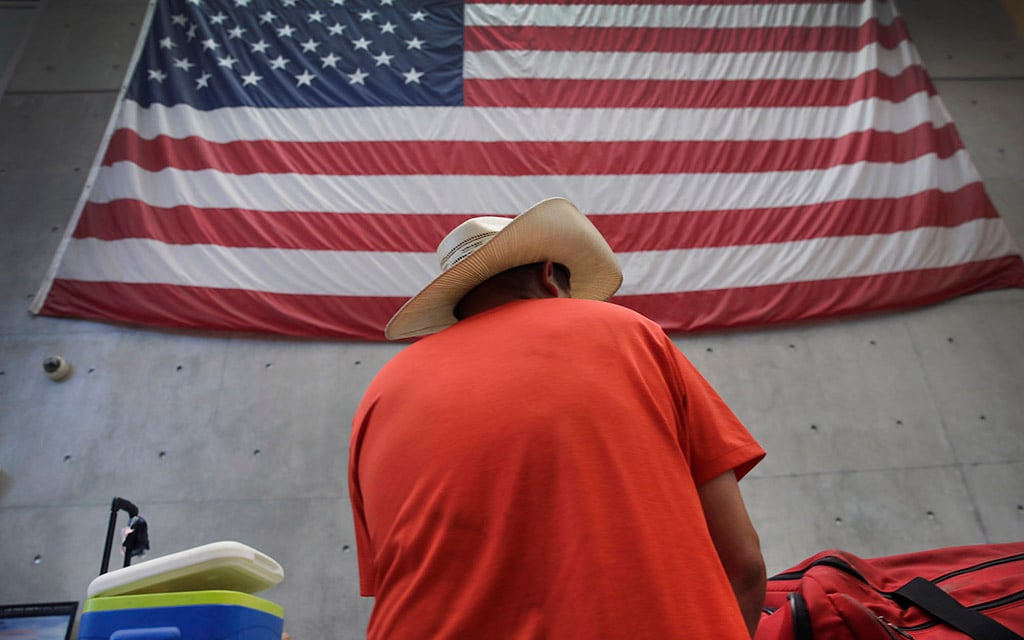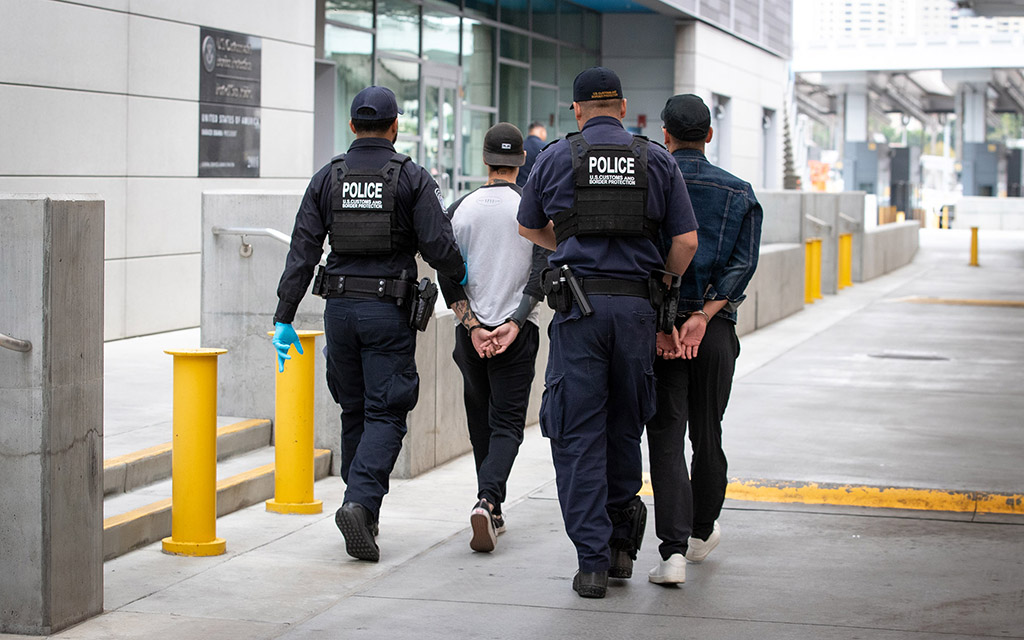
The number of migrants crossing the southern U.S. border reached record highs in December, but a decades-long stalemate in Congress may scuttle the latest immigration reform bill. Here, a passenger arriving legally in the U.S. by bus from Mexico retrieves his luggage after Customs and Border Protection screening in Laredo, Texas, in July. (Photo by Glenn Fawcett/Customs and Border Protection)
WASHINGTON – The bipartisan immigration reform bill unveiled in the Senate late Sunday includes $1.4 billion to help border communities grappling with the migrant surge, in addition to funding for Ukraine and Israel.
The money for the Migrant Shelter and Services Program, which helps communities and nonprofits along the border provide assistance to migrants, is part of a $6 billion pot of money in the bill that would go toward beefing up border security.
But the overall $118 billion measure faces an uphill fight in Congress, where critics from both sides of the aisle have attacked it and House Speaker Mike Johnson declared it “dead on arrival” even before seeing the bill.
But officials in border towns said Monday that it is “not the perfect bill, but it’s a great step in the right direction.”
“It’s one of those things that we’ve been asking for for a while. It really focuses on our nonprofits,” said Yuma Mayor Doug Nicholls. “That funding will help bolster our nonprofits and make sure that the great work that they’ve been doing can continue until this thing truly gets resolved.”
That optimism was echoed by Douglas Mayor Donald Huish who said he believes the bill would “help everyone involved because it will force the orderly immigration into our country.”
The bill includes billions of dollars in aid for Ukraine, Israel and Taiwan, along with increased Pentagon funding to replenish military supplies that have been transferred to those nations. But the bulk of the 370-page bill is aimed at restricting immigration.
Among those changes is a proposal to grant the government new authority to shut down the border when immigration reaches a certain daily threshold: The Homeland Security Department could shut it down when the number of migrants averaged 4,000 per day over a week, and would be required to shut it down when the average hits 5,000. The bill also includes funding to hire more Border Patrol agents.
The bill also includes language that would tighten asylum standards and would take processing of asylum claims out of the courts – where it can currently up to a decade for a case to be heard – and puts in the hands of U.S. Citizenship and Immigration Services officers. USCIS would have to hear cases within six months, one step toward ending what critics call the current “catch-and-release” process of handling asylum seekers.
Other provisions include the addition of 50,000 new employment and family-based visas per year over the next five years, legal counsel for children under age 13 who show up at the border and language that said other migrants can have an attorney, but not at government expense and only if it does not delay processing.
Within hours of its release, advocates on both sides of the issue were criticizing the bill.
“There’s a lot more money in this bill going to Ukraine’s borders than our borders. It’s hard to understand why they have such a lack of regard for our own sovereignty,” said Federation for American Immigration Reform President Dan Stein.

Customs and Border Protection officers at the San Ysidro Port of Entry in California detain two men for further inspection in this October photo. (Photo by Jerry Glaser/Customs and Border Protection)
Stein called the proposal “a hodgepodge of mixed messages” noting that while it claims to target immigration, senators “want to appropriate all of the money to NGOs to continue to process people in.” He said the bill does nothing to reduce incentives for immigrants to try to enter the U.S.
Andrea Senteno, Washington, D.C., regional counsel for the Mexican American Legal Defense and Educational Fund, agreed that the bill will not solve the problems at the border, but she cited different reasons.
“We need Congress to put serious and significant time into addressing the many challenges that we face as a country in fixing our immigration system,” Senteno said. “Thats not this bill.
“This bill does nothing for individuals that have been in this country for a very long time and do not have a way to seek any path toward a green card or any eventual citizenship, despite the fact that they’ve built their lives here,” she said. “There are millions of immigrants already living in the United States who have been left out of this legislation.”
While he likes the bill’s overall objectives, Huish said he worries about the details, like whether there is infrastructure in place to account for the streamlined asylum processing outlined in the bill.
“I know there’s limits to make sure that the people that are allowed in will be able to have their case reviewed quickly with a maximum of six months,” Huish said. “However, my primary concern with the bill is, where will these people stay for those six months?”
Despite shortcomings in the bill, Huish called it a “great starting point” and urged House Republicans to work on improving it and not scrapping the idea entirely.
“I’m sure as we dig down into things there’s going to be issues that are uncomfortable, and if that’s the case then bring them up and let’s talk about them and work to resolve them. The most exciting part is that it puts order back on the border,” Huish said.
Nicholls agreed that the bill should be seen as the first step in a process toward immigration reform, and not as an immediate fix.
“Hardline immigration policy is really where we need to go, and I think is a step in that direction,” he said. “We need more effective things like emergency powers. Once those are in place I think those threshold numbers can be adjusted and reduced to be more and more impactful.”
Nicholls said the biggest piece of the puzzle is making sure that the additional funding for border communities “is actually getting to border communities.”
“I understand that cities across the country are having problems, but these issues really start in our border communities so let’s get them fixed and we’ll see a ripple effect in other cities,” he said.


